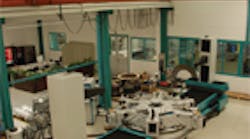When coordinate-measuring machine builder Wenzel GmbH was presented with the challenge of designing a CMM solution for inspecting large ring gears and bearings used by a manufacturer of large construction cranes, it designed and built a machine that combines standard components and proven dual-arm measuring technology with the precision air-bearing mechanics of its Wenzel WGT series gear checkers and Renishaw scanning probes. The inspection machine is capable of inspecting bearings and ring gears up to 6,000 mm (19.68 ft) in diameter.
The dual-arm machine design is similar to what Wenzel has applied in the automotive industry to measure car bodies and body components. In this design, each CMM measuring arms is mounted to a table, which in turn is mounted on a large corresponding granite base. The measuring arms have high-accuracy linear guideways for the X-axis. The Y and Z-axes feature finely tuned, preloaded roller bearings that ensure minimal friction and operational wear.
The base units are positioned opposite to each other, with a rotary fixture table in between. Both arms measure the large rings concurrently and the metrology of each measuring arm is harmonized through the use of a specially designed calibration tool. The ring gears and bearings are located and clamped on the 2,200 mm (7.21 ft) diameter hydrostatic rotary table that can handle loads up to 100,000 lbs.
Each ring has its complete circumference inspected by a single inspection part program. The two measuring arms are equipped with Renishaw SP80 scanning probes. Application software also is provided, to calculate the optimum fitting tolerance for inner and outer bearing components.
Wenzel anticipates that this “large ring” inspection solution will have additional application in the aircraft engine, wind energy, and construction equipment markets.
Xspect Solut ions Inc., a wholly owned subsidiary of Wenzel GmbH, is one of the largest suppliers of traditional CMMs and GMMs (gear measuring machines) in North America.
| ASTM Issues New Standard for Creep-Fatigue Crack Growth Rate Saxena says that the maximum operating temperature of turbines and power plant components depends on the ability of materials to resist sustained and cyclic loads at high temperatures. This is particularly true for metals used in critical structural components of engines. Chemical process equipment also may benefit. “The lives of these components at high temperatures are determined by the creep-fatigue properties of the materials used in these applications,” Saxena says. Also, the proposed standard will be useful for extending service life of existing engines and generators through a more accurate creep-fatigue analysis, thereby postponing replacement. ASTM invites interes ted par ties to participate in the development and “round robin testing” of WK21984.Contact Prof. Saxena at 479-575-3054; or [email protected]. |
| GE Energy’s Introduces Wireless Condition Monitoring Wireless sensor technology enhances work safety for maintenance personnel by improving their ability to monitor equipment in hazardous areas, according to GE Energy; it also improves productivity and speeds up data analysis. Essential Insight.mesh has several components: a sensor, for up to four inputs; a repeater, which extends the mesh network coverage for broader communications; a manager gateway, which enables communication with other networks and protocols, and serves as the network manager; and vibration and thermocouple probes. “Our Essential Insight.mesh wireless condition-monitoring solution has been tested in the extreme environments of the oiland- gas and power generation industries. It has been developed with some of our most meticulous customers,” according to Brian Palmer, v.p., GE Energy, optimization and control. The company lists Norsk Hydro’s and Norske Shell’s Ormen Lange gas fields in Norway, among other remote and distributed equipment assets where it has been adopted. “It enables reliable and affordable condition monitoring on what can still be categorized as essential machinery where conventional technology has traditionally reached its limits,” Palmer says. |










